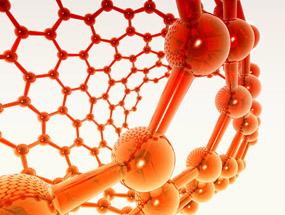EPA Science Matters Newsletter: Nanomaterials: Harnessing the Potential, Understanding the Risks (Published January 2014)
Tiny materials with big benefits
 Photo of silver nanoparticles under 600x magnification.
Photo of silver nanoparticles under 600x magnification.Nanomaterials are extremely small particles that measure between one and 100 nanometers in size. How small is that? A single nanometer is one billionth of a meter, and a strand of human hair is about 80,000 nanometers wide!
These tiny materials often exhibit unique properties that are different from those of the same substances in a larger size. Nanomaterials are used in many processes and commercial products, from paint and cosmetics, to treated wood and electronics.
According to the National Nanotechnology Institute, more than 800 everyday commercial products now rely on nanoscale materials and processes.
EPA researchers are combining the promise of nanotechnology with sustainable chemistry to develop safer, more sustainable processes and products. They are also working to better understand the potential risks to humans and the environment from nanomaterials.
- Tapping the Benefits
EPA chemist Dr. Rajender Varma and his team are developing safer nanomaterials as options to replace conventional catalysts, substances used to initiate or speed up chemical reactions. Catalysts can be expensive, dangerous if not handled properly, and can create excess waste that ends up in the environment.
By building nanomaterial-based catalysts out of safer substances, Dr. Varma and his colleagues are creating alternatives that reduce the use of hazardous substances. Made from iron and other metals, these nano-based catalysts, being magnetic, can be easily recovered after use by using an external magnet. This allows the catalysts to be re-used over and over again, reducing waste.
“In addition to helping us make safer chemical products and processes, researching and developing technologies that use safe materials such as water and developing nanomaterials that can be recovered and reused will hopefully make EPA a leader in developing sustainable methods going forward, ” says Dr. Varma.
- Understanding the Risks
While the development and use of safer nanomaterials offers the promise of more efficient and less wasteful catalysts, the use of other nanomaterials and impacts to human health and the environment has not been well studied. EPA researchers are collaborating with industry and other stakeholders to assess the potential impacts of the use of nanomaterials.
One research project includes partners in the United Kingdom who are investigating the effects of cerium oxide nanoparticles added in a diesel fuel additive designed to decrease emissions and increase fuel efficiency.
The researchers are sampling air in areas in England where cerium oxide-based fuel additives are being used in diesel buses. Using data collected in the study, scientists will build a computer model to examine how cerium oxide changes the composition of emissions from the buses. They are also looking at how emissions particles move from roadways to nearby areas where people may live and work.
Preliminary results indicate that there may be significant differences in the size and composition of particles emitted from engines using cerium-oxide fuel additives. Research results will provide information to inform future research directions.
- Nanomaterial Research at EPA

As part of a large US and international research collaboration, EPA is leading scientific efforts to understand how products containing nanomaterials interact with people and the environment. This research provides scientific tools and data to inform the development of more sustainable and effective nanomaterials, while also providing knowledge to decision-makers to inform policies made about these materials. Some highlights from this effort include research on:
- Nanosilver: Silver nanoparticles can prevent the growth of some bacteria or fungi, making them a key ingredient in every-day products such as body soap, laundry detergent, and toothpaste. To investigate potential health risks of nanosilver, scientists from EPA and the University of Nevada, Las Vegas researched the changes that occur when nanosilver interacts with the acidic environment of a synthetic human stomach. Results showed that nanomaterials could alter the amount of silver that is absorbed by the body.
- Collaborative Research on Micronized Copper & Nanosilver: EPA and the U.S. Consumer Product Safety Commission (CPSC) are collaborating to assess consumer products that contain nanomaterials. Researchers are developing the tools, approaches, and protocols needed to evaluate the impact of nanoparticles on susceptible populations (e.g., children). For example, preliminary study results, conducted on 13 products containing nanosilver, indicate that the silver levels to which susceptible populations may be exposed during normal product use could be relatively low.
- EPA researchers are evaluating the use of nanomaterials in an array of products using high throughput toxicity assays to evaluate these new materials. This research will allow EPA to quickly evaluate nanomaterials. This research will also help identify the unique make up of nanomaterials that make them an effective ingredient in consumer products while also providing data that can be used to develop more sustainable nanomaterials.
- Real World Applications: EPA is developing case studies on particular nanomaterials in specific applications. These case studies are being used to ground research findings in real-world scenarios and to help inform risk assessments. A 2013 case study on nanosilver explains what is known and, more importantly, what is not yet known about these nanomaterials. This information will be of great value in assessing the broad implications of nanomaterials to human health and the environment.
In addition to research collaborations, EPA provides funding to external organizations to advance nanomaterials research. EPA also offers opportunities for small business research grants and fellowships for both undergraduate and graduate students.
